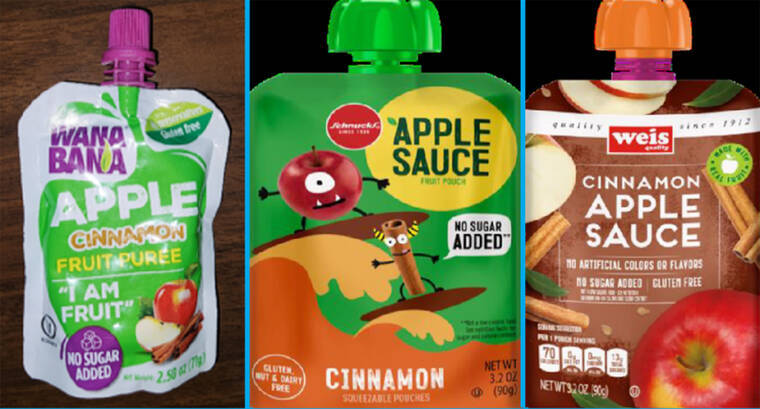‘Extremely high’ lead levels in cinnamon at Ecuador plant that made fruit pouches

FDA VIA ASSOCIATED PRESS
This image provided by the U.S. Food and Drug Administration, on Nov. 17, shows three recalled applesauce products — WanaBana apple cinnamon fruit puree pouches, Schnucks-brand cinnamon-flavored applesauce pouches and variety pack, and Weis-brand cinnamon applesauce pouches. U.S. food inspectors found “extremely high” lead levels in cinnamon at a plant in Ecuador that made applesauce pouches tainted with the metal.
U.S. food inspectors found “extremely high” levels of lead in cinnamon at a plant in Ecuador that made applesauce pouches tainted with the metal, the Food and Drug Administration said today. The recalled pouches have been linked to dozens of illnesses in U.S. kids.
Cinnamon tested from the plant had lead levels more than 2,000 times higher than the maximum level proposed by the FDA, officials said.
The samples came from ground or powdered cinnamon from Negasmart, an Ecuadorian company that supplied the spice to Austrofoods, which made the pouches. The applesauce pouches were sold under three brands — WanaBana, Schnucks and Weis. Officials with Austrofoods did not respond to requests for comment about the investigation.
FDA said lead has not been detected in WanaBana products made without cinnamon and sold in the U.S.
The agency continues to investigate how the cinnamon was contaminated. Jim Jones, who heads the agency’s human foods program, said in an interview with Politico last week that the lead contamination appeared to be “an intentional act.”
One theory is that the cinnamon may have been contaminated for economic reasons, agency officials said. That could mean an ingredient is added or subtracted from a food to to boost its value. For example, compounds like red brick, red lead salt, lead oxide and lead chromate, which mirror cinnamon’s red color, have been added to increase the value of the spice, research shows.
Don't miss out on what's happening!
Stay in touch with breaking news, as it happens, conveniently in your email inbox. It's FREE!
FDA officials said they “cannot take direct action” with Negasmart and are relying on officials in Ecuador for the investigation into the company’s actions. Negasmart does not ship product directly to the U.S. and of Negasmart’s customers, only Austrofoods shipped foods to the U.S., the agency said.
At least 125 children from 22 states may have been sickened by lead poisoning since late October, the Centers for Disease Control and Prevention said. Using a different reporting method, the Food and Drug Administration counts at least 65 kids ages 6 and younger sickened in 27 states as of Dec. 8.
Tests show children who ate the pouches had blood lead readings up to eight times higher than the reference level that sparks concern, health officials said. Samples of the puree showed lead contamination more than 200 times higher than the FDA allows, officials said.




